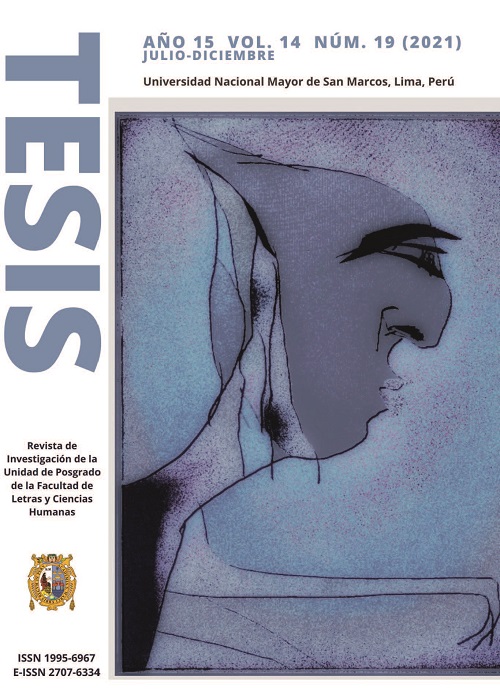Homología y teleosemántica: el problema de la identidad del rasgo biológico
DOI:
https://doi.org/10.15381/tesis.v14i19.21931Palabras clave:
homología, función biológica, teleosomántica, tetracromaciaResumen
La teleosemántica es la teoría que propone una explicación de la representación mental sobre la base de la teoría darwiniana de la función biológica. Aunque Darwin explica los rasgos biológicos tanto por causas históricas como adaptacionistas, Papineau y otros proponentes de la teleosemántica se apoyan solo en la dimensión adaptacionista de la teoría para dar cuenta de la identidad del rasgo biológico. Esto se muestra en la respuesta de la teleosemántica a la posibilidad de que surgiera por causas no evolutivas un duplicado exacto de un ser humano (el hombre del pantano). Aclarar la cuestión acerca de la naturaleza homológica de la identidad del rasgo es central para enfrentar el argumento del hombre del pantano. Este argumento se ha renovado bajo la forma de un contraejemplo empírico: la existencia de la tetracromacia funcional, una condición que constituiría un caso real de representación mental que no es el resultado de un proceso de selección. Argumentaré que la teleosemántica puede responder al desafío de la tetracromacia sobre la base de una verdadera concepción evolucionista de la identidad del rasgo biológico.
Referencias
Amundson, R. (2012). Homology and homoplasy: A philosophical perspective. Wiley Online Encyclopedia of the Life Sciences.
Brooks, D. R. y McLennan, D. A. (2002). The nature of diversity. An evolutionary voyage of discovery. The University of Chicago Press.
De Pinna, M. C. (1991). Concepts and tests of homology in the cladistic paradigm. Cladistics, 7, 367-394.
Davidson, D. (1987). Knowing one’s own mind. Proceedings and Addresses of the American Philosophical Association, 60, 441-458.
Darwin, C. (1859). On the origin of species. John Murray.
Fodor, J. y Piattelli-Palmarini, M. (2010). What Darwin got wrong. Farrar/Straus/ Giroux.
Garson, J. y Papineau, D. (2019). Teleosemantics, selection, and novel contents. Biology & Philosophy, 34(36). https://doi.org/10.1007/s10539-019-9689-8
Gould, S. J. (2002). The structure of evolutionary theory. The Belknap Press of Harvard University Press.
Gould, S. J. y Lewontin, R. (1979). The spandrels of San Marco and the Panglossian paradigm: a critique of the adaptation-ist programme. Proceedings of the Royal Society of London, B205(1161), 581-598.
Goodwin, B. C. (1982). Development and evolution. Journal of Theoretical Biology, 97, 43-55.
Goodwin, B. C. (1994). How the leopard changed its spots. The evolution of complexity. Princeton University
Hebert, P. D. N., Stoeckle, M., Zemlak, T. y Francis, C. (2004). Identification of birds through DNA barcodes. PLOS Biology, 2(10), e312. doi.org/10.1371/journal.pbio.0020312
Hebert, P. D. N., Hollingsworth, P. M y Hajibabaei, M. (2016). From writing to reading the encyclopedia of life. Philosophical Transactions of the Royal Society B, 371(1702): 20150321. doi: 10.1098/ rstb.2015.0321
Ereshefsky, M. (2009). Homology: integrating phylogeny and development. Biological Theory, 4(3), 225-229.
Holmes, B. (2004). Barcode me. New Scientist, 182, 32-35.
Kekkonen, M. y Hebert, P. D. (2014,). DNA barcode-based delineation of putative species: efficient start for taxonomic workflows. Molecular Ecology Resources, 14, 706-715. doi:10.1111/1755- 0998.12233
Lee, M. (2004). The molecularisation of taxonomy. Invertebrate Systematics, 18(1), 1-6. doi: doi.org/10.1071/IS03021
Mayr, E. (1966). Animals species and evolution. Harvard University Press.
Matthen, M. (2000). What is a hand? What is a mind? Revue Internationale de Philosophie, 54(214[4]), 653-672.
Matthen, M. (2007). Defining vision: what homology thinking contributes. Biology and Philosophy, 22, 675-689.
Millikan R. (1996). On swampkinds. Mind Lang, 11(1), 103-117.
Millikan, R. (2004). The varieties of meaning. MIT Press.
Owen, R. (1843). Lectures on the comparative anatomy and physiology of the invertebrate animals, Delivered at the Royal College of Surgeons, in 1843. Longman, Brown, Green, and Longmans.
Owen, R. (2012 [1849]). Discurso sobre la naturaleza de las extremidades. (Sergio Balari, Trad.). KRK.
Papineau, D. (2000). Cómo evitar matar al hombre del pantano. En J. Botero, J. Ramos y Rosas, A. (Eds.), Mente reales. La ciencia cognitiva y la naturalización de la mente (pp. 81-100), Siglo del Hombre Editores.
Papineau, D. (2017). Teleosemantics. En D. L. Smith (Ed.), How biology shapes philosophy (pp. 95-120). Cambridge University Press.
Porter, B. (2020). Teleosemantics and tetrachromacy. Biology & Philosophy, 35(10). https://doi.org/10.1007/s10539-019-9732-9
Pust, J. (2004). Natural selection and the traits of individual organisms. Biology & Philosophy, 19(5), 765-779.
Razeto-Barry, P. y Frick, R. (2011). Probabilistic causation and the explanatory role of natural selection. Studies in History and Philosophy of Biological and Biomedical Sciences, 42(3), 344-355.
Roffé, A. J. (2020). Dynamic homology and circularity in cladistic analysis. Biology and Philosophy, 35(21). https://doi-org.ezpbibliotecas.udec.cl/10.1007/s10539-020-9737-4
Seyfarth, R., Cheney, D. y Marler, P. (1980). Monkey responses to three different alarm calls: Evidence of predator classification and semantic communication. Science, 210, 801-803.
Sober, E. (1984). The nature of selection. Evolutionary theory in philosophical focus. The University of Chicago Press.
Sober, E. (1995). Natural selection and distributive explanation: A reply to Neander. British Journal for the Philosophy of Science, 46, 384-397.
Torres, J. (2014). Causalidad y evidencia en la argumentación darwiniana. TEOREMA. Revista Internacional de Filosofía. XXXIII(1), 57-66.
Torres, J. (2015). Selección natural y condicionamiento de operantes: una crítica a la analogía de Fodor y Piattelli-Palmarini. SCIENTIAE STUDIA. Revista Latino-Americana de História e Filosofia da Ciência, 13, 485-720.
Torres, J. (2020). Código de barras de ADN: Problemas conceptuales de una analogía científica. Análisis Filosófico, 40(2), 169-185. http://dx.doi.org/10.36446/af.2020.352.
Webster, G. Y Goodwin, B. (1996). Form and transformation: Generative and relational principles in biology. Cambridge University Press.
Wittgenstein, L. (1969). The blue and brown books. (2.ª ed.). Blackwell Publishing.
Wittgenstein, L. (1988[1953]). Investigaciones filosóficas. (Alfonso García Suárez y Ulises Moulines, Trads.). Crítica.
Descargas
Publicado
Número
Sección
Licencia
Derechos de autor 2021 Julio Torres Meléndez

Esta obra está bajo una licencia internacional Creative Commons Atribución 4.0.
LOS AUTORES RETIENEN SUS DERECHOS:
a. Los autores retienen sus derechos de marca y patente, y también sobre cualquier proceso o procedimiento descrito en el artículo.
b. Los autores retienen el derecho de compartir, copiar, distribuir, ejecutar y comunicar públicamente el artículo publicado en la revista Tesis (Lima) (por ejemplo, colocarlo en un repositorio institucional o publicarlo en un libro), con un reconocimiento de su publicación inicial en la revista Tesis (Lima).
c. Los autores retienen el derecho a hacer una posterior publicación de su trabajo, de utilizar el artículo o cualquier parte de aquel (por ejemplo: una compilación de sus trabajos, notas para conferencias, tesis, o para un libro), siempre que indiquen la fuente de publicación (autores del trabajo, revista, volumen, numero y fecha).














